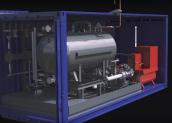Design - Simulation - Tests
Headlines

Hydrogen distribution: the results of the H2REF project are unveiled!
The partners of the European project intended to develop an H 2 distribution station based on an unprecedented concept have presented the first functional prototype which paves the way to commercial production.
The new generation of hydrogen distribution stations developed in connection with the H2REF (Development of a cost effective and reliable hydrogen fuel cell vehicle refuelling system) project works! On 27 February 2020, during a live webinar from Sunderland (United Kingdom), the project partners officially announced that the first prototype assembled and tested at the premises of Haskel has delivered on its promises. The prototype is comprised of a set of 16 tanks and a hydraulic system (see photograph) that is used to pressurise the tanks. Indeed, it serves to compress and store the dihydrogen at 900 bars in tanks to then distribute them in hydrogen fuel cell vehicles. The key to the success of this project is rather than compressing the gas and then storing it, this station does both at the same time: the hydrogen is introduced into bladders installed inside the composite tanks and a hydraulic system injects pressurised oil between the two to compress the gas. Further to the successive pressurisation and transfer of the gas, the system can rise to 900 bars and must withstand a large number of cycles with minimum maintenance.
Cetim, a key partner of the project
Funded by the fuel cells and hydrogen 2 joint undertaking (FCH JU2), H2REF is led by a consortium, jointly headed by Cetim and H2NOVA, which is composed of four European players (Hexagon, Haskel, CCS and LBST) as well as UTC as a Cetim contractor. In addition to jointly leading the project, Cetim provided its expertise during the modelling of the fluid system and in the development of the hydraulic device (alongside UTC) responsible for injecting the oil into the composite tanks housing the bladders. Cetim also carried out the qualification tests of the accumulators manufactured by Hexagon as well as the water burst test under very high pressure. To this end, it adapted the test resources so as to safely carry out the test campaigns under 2,200 bars on the 75 litre tanks.
The project is now complete. It may continue with a new optimisation phase before commercial production over a 3-year timeframe.
To watch the replay of the project presentation webinar and learn about the technology through a video animation, consult the project site.
Other informations
VibSEA – Controlling high frequency vibrations of aircraft engines
Headlines
The European project provides a response to the need of engine manufacturers to extend the fiel...
Video: Cetim takes up the challenge of metal additive manufacturing
Headlines
In a new video, Philippe Lubineau, Chief Research Officer at Cetim, talks about this key techno...
Video: “I am Sure” project monitors metal additive manufacturing
Headlines
detection of incipient defects reveals its results in a new video. The “I am Su...
Results of studies
ASME Boiler and Pressure Vessel - Code Week Meetings - November 2019 - Version Anglaise
Dimensioning of form tapping – Phase 3
Tests of synthetic ropes –Lf200 curve
Material fatigue - Factors influencing the fatigue strength of metal of metal materials
JTC10 – Material efficiency – Summary of standards
References
Aluminium foams released into the stratosphere
( CNES)Remaining useful life: the turbine remains in operation
( Suez EVNA)CFD simulation to optimise performance
( TotalEnergies Fluids)Comprehensive support for validation plans
( Sonceboz)Support at every stage of development
( Purple Alternative Surface)Presentation
With product modelling and simulation potential solutions can be virtually optimized before they are really implemented. We tend to set up a more efficient design by taking fatigue life into account and optimizing safety factors within a fiabilist approach. The main goal is to achieve much shorter development deadlines. Major improvements are experienced in the field of simulation dealing with more and more complex and multi-physical phenomena.
This technological focus includes projects relating to : fiabilist design of products, functional requirement and performance qualification checking, analysis methods based on customer needs, design of clean and silent products, simulation of product behavior and operation.




